Whether you’re an expat family or are simply visiting Japan with your baby or toddler, it’s easy to get lost in translation. This guide has all you need to know about baby diapers in Japan.
Let’s begin with an indispensable (and messy!) part of child rearing–diapers.
Aside from this guide, check out our resources for traveling in Japan with your baby:
- 33 Best Tours & Things to do in Tokyo with a Baby or Toddler
- Baby Formula Milk in Japan: The Complete Guide [2019 Update]
- How to Choose a Baby-Friendly Accommodation in Japan
The Best Places to Buy Diapers in Japan
For short-term travelers
The best place to find diaper is through Create and Welcia Drug Stores. However, these drug stores are only prevalent in residential areas. So if you have to stay in a residential area in Tokyo, Kyoto or Osaka cities, make sure to look for these drugstores first. If you happen to be in a touristy spot, I recommend Matsumoto Kiyoshi drugstore and Mega Don Quijote as they almost always have stocks of baby diapers.
Mega Don Quijote is better than Don Quijote because Mega Don Quijote stores usually have a big selection of baby and toddler goods. Please note that the convenience store is the last place to search. Despite their prevalence across Japan, convenience stores rarely stock diapers. If you do come across diapers in a convenience store, you’ll immediately notice a meager selection of brands. A stock is typically limited to pack of 4 or 5 diapers and are in sizes M or L.
Several months ago, I came across a 2-pack of Goo.N diapers in the baby goods section of the 100 yen store chain Daiso. But, avoid relying on Daiso as the stock may vary by branch.
For expats or long-term residents
If it’s your first time shopping for diapers in Japan, buy in person to get an idea of what’s on the market. Check out your local drugstore (again, I recommend Create and Welcia), and discount retail chains such as Mega Don Quixote and Costco. And of course, shops specializing in baby and toddler goods such as Akachan Honpo, Nishimatsuya, and Babies ‘R’ Us.
Diapers are bulky in nature, so you ideally want to purchase them online. By doing so, you won’t have to worry about juggling both baby and bundles of diapers home. When it comes to shopping online, most expats in Japan prefer Amazon Japan. Amazon Japan Prime members should sign up for Amazon Family, where diapers can be purchased for 15 percent of the retail price with FREE shipping.
Before you shop online, however, do consider taking a trip to a brick and mortar store like Akachan Honpo or Babies ‘R Us to examine diapers in person. Costco, of course, is also another excellent option for those seeking to buy in bulk.
For U.S. military stationed in Japan
Japanese diapers are actually cheaper than Amazon US, Commissaries, and Exchange. Even if combined with coupons, Japanese diapers will still turn out to be cheaper. Aside from that, Japanese diapers have better quality and softer material. Thus, are great for sensitive skin and preventing rash compared to American brands.
Popular Japanese Diaper Brands
These are the six diaper brands you will encounter when shopping for diapers in Japan: Genki, Goo.N, Mamy Poko, Merries, Moony, and Pampers.
1. Genki!
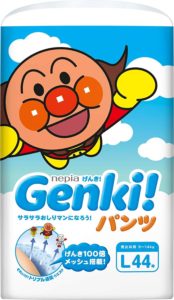
Best Known For: Most ultra-absorbent diaper of all Japanese diapers–effective against a leak.
Genki means happy, energetic and healthy in English. For this reason, Genki diapers frequently make their way into the shopping carts of Japanese parents. It is even popular among Malaysian parents in Japan.
Genki is manufactured by Oji Nepia, a company who manufactures the popular Nepia toilet paper brand. Compared to other Japanese diapers, Genki diapers are slightly thicker, thus it does a great job of preventing leaks.
Genki diapers are mainly for older babies, they are only available as pants or pull-up type.
2. Goo.N
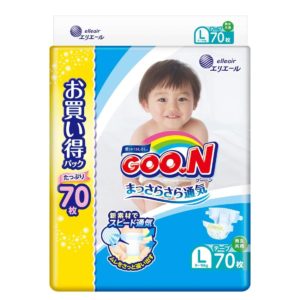
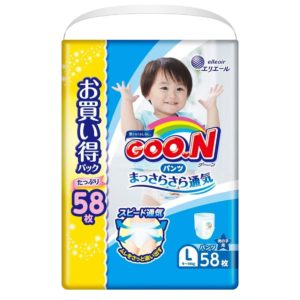
Best Known For: Affordability and very soft which is great for sensitive skin.
Goo. N has an impressive sizing range. Beginning with preemie sizes all the way up to 35 kg (77 lbs). Its diapers feature characters from the hit NHK TV show “Inai Inai Baa! (Peek-a-boo!).”
Goo.N diapers are super absorbent and allow for maximum breathability to keep your child’s skin dry. Lastly, Goo.n’s “Marshmallow” lineup (はじめての肌着 マシュマロ仕立て) has a lining which also contains Vitamin E.
3. Mamy Poko
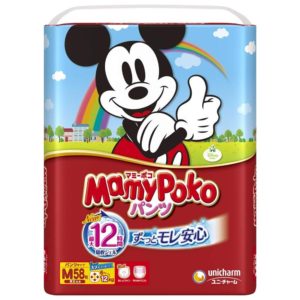
Best Known For: Mamy Poko is best for potty training diaper and affordability.
Mamy Poko diaper sizes begin at “M” (Medium-sized 6 kg and above), which means that they are geared towards older babies who are potty training. One package of diapers comes with several different baby Mickey Mouse designs on them.
Mamy Poko diapers feature Unicharm’s unique absorption polymer which can hold urination for up to 12 hours without leaking.
4. Merries
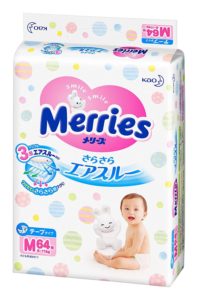
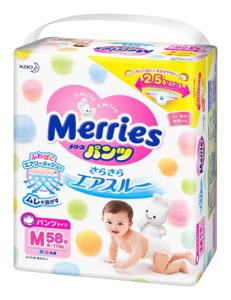
Best Known For: The most breathable brand of diaper in Japan.
Merries rank high in breathability, absorption, cost-performance, fit, and durability. If you are interested in Eco-friendly disposable diapers, you may want to try Merries’ Natural lineup made of 100 % organic cotton.
5. Moony
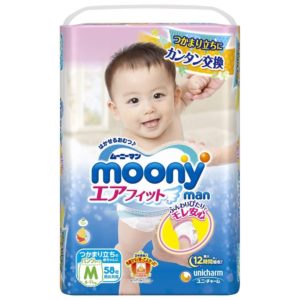
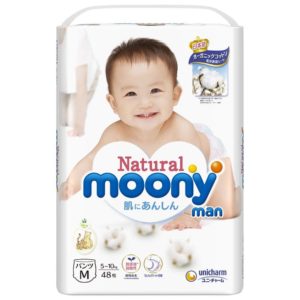
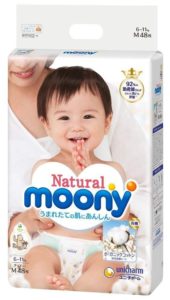
Best Known For: Affordability, character design, and very soft which is great for sensitive skin.
Moony is made by Unicharm, a Japanese company that also produces several brands of sanitary napkins and adult diapers. So, if leakage is your biggest concern, you might want to pick up a package of Moony diapers.
Moony is also popular for newborns as the waistband has a unique indentation to accommodate an infant’s sensitive belly button. Like Merries, Moony also has a “Natural” diapers lineup made of organic cotton and features “Pooh” as its diaper design.
6. Pampers
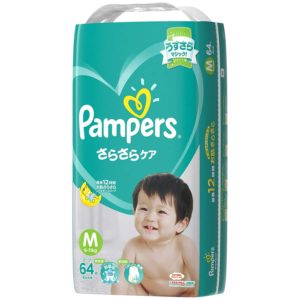
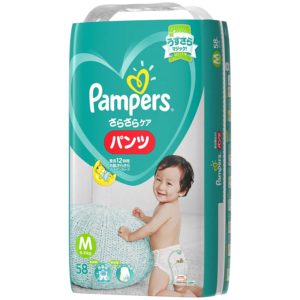
Best Known For: Loyalty reward program.
Pampers is perhaps the most popular brand of diapers in Japan mainly because of its great loyalty program. In addition, most hospitals and birth clinics in Japan use Pampers because of the partnership that Pampers established.
Pampers absorb urine with its proprietary absorbent gel which maintains a low acidity level inside the diaper. The elastic waistband creates a snug fit around the waist and legs without hampering a growing baby’s movement.
7. Oyasumi Man
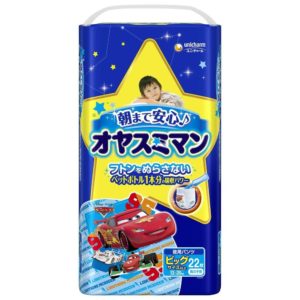
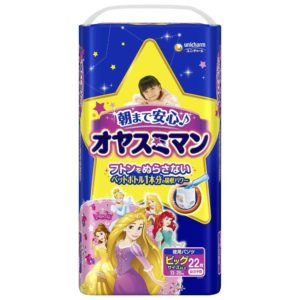
Oyasumi Man is a brand of nighttime diapers for toddlers being potty trained. It features the Disney film Cars as well as Disney princesses. They are available in L (9-14 kg) and Extra Large XL (13 – 25 kg).
Types of Japanese Diapers
You will find 3 types of diapers in Japan:
- tape (テープ | te-pu)
- pants (パンツ | pantsu); or pull-ups
- swim diapers (水あそびパンツ | mizu asobi pantsu); or water play pants
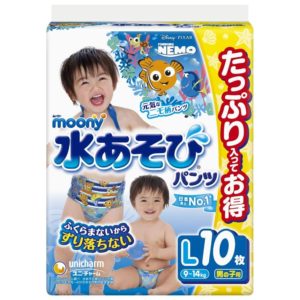
You might wonder which type of diaper (tape or pull-up) is right for you. A good guideline to make the switch is when your baby can hold up their head, roll over, or crawl.
However, you might want to consider switching to pull-up diapers if your baby’s leg movements during diaper changes are a bit too much to handle.
For older babies and toddlers undergoing potty training, you may want to pick up a package of overnight diapers such as Oyasumi Man.
As for swim diapers, only Moony carries them.
How to Read Diaper Sizing
Diaper sizes in Japan are typically expressed by letter sizes (i.e. S, M, L) and a baby’s weight.
Some Japanese diaper brands may also determine size by a baby’s developmental milestone (i.e. crawling, walking).
Sizes and fit vary from brand to brand so keep this in mind when shopping for diapers.
Please refer to the below table for a guide to Japanese diaper sizes according to letter size, weight, and developmental milestones:
The usual tape diaper sizing
| Baby’s Weight | Size |
|---|---|
| Low Birth Weight or Premature Babies (up to 3.5 kg or 8 lbs) | 新生児小さめ (shinseiji chīsame) |
| Newborn (up to 5 kg or 11 lbs) | 新生児 or ねんね (newborn or nen ne) |
| Up to 4-8 kg (9-18 lbs) | S |
| Up to 6-11 kg (13-24 lbs) | M |
| Up to 9-14 kg (20-31 lbs) | L |
The usual pants diaper sizing
| Baby’s Weight | Size |
|---|---|
| Up to 4-8 kg (9-18 lbs) | S |
| Up to 6-10 kg (13-22 lbs) | M |
| Up to 9-14 kg (20-31 lbs) | L |
| Up to 12-22 kg (26-49 lbs) | ビッグ (Biggu or XL) |
| Up to 15-28 kg (33-62 lbs) | ビッグより大きい (Biggu Yori Ooki or XXL) |
Other Diaper Descriptions (Japanese-English Translation)
| ねんね (nen ne) | Newborn babies |
| ねがえりor 寝返り (negaeri) | For babies who can roll over |
| ハイハイ (hai hai) | For babies who can crawl |
| おすわり (osuwari) | For babies who can sit unassisted |
| たっち (tatchi) | For babies/toddlers who can stand unassisted |
| 一人歩き (hitori aruki) | For babies/toddlers who can walk unassisted |
| トレーニング (tore-ningu) | To be used during the potty training stage |
| 卒業 (sotsugyou) | To use in the final stage of potty training |
Japanese Diaper Features
1. Wetness Indicator. You’ll notice that both tape and pull-up diapers in Japan have a yellow line or several stripes running down the middle and up the back of the baby’s diaper. This stripe will turn blue when wet, indicating that your baby’s diaper should be changed.
2. Removal and Disposal Convenience. The sides of pull-up diapers can be torn at the seams with little effort, making diaper changing a breeze. The tape tab on the back of pull-up diapers is used when rolling up a soiled diaper. Simply roll the diaper into a burrito, pull down the tape tab, and fasten the diaper shut. While tape-type diapers have the benefit of adjustable sizing thanks to the fasteners on either side.
Diaper Disposal Etiquette in Japan
In Japan, waste is separated into several categories: recyclables, combustible, non-combustible, cloth, plastics, oversized garbage, etc.
Furthermore, specific categories of garbage are collected solely on certain days of the week and must be put out only on those specified days. This is further complicated by the fact that waste disposal rules vary by municipality while waste collection dates differ by neighborhood!
With this said, as a general rule, diapers are combustible or burnable trash (燃えるゴミ or 燃えやすゴミ). However, diapers must be disposed of (bagged) separately, and not with other combustible waste.
Aside from the garbage disposal rules, another surprising fact about throwing away diapers in Japan is that a solid stool is flushed before disposing of diapers!
Lastly, when you are out in public, the general rule is to take soiled diapers home for disposal. You may, however, dispose of your baby’s diapers if the bathroom has a specially designated trash can for diapers.
Cloth Diapering in Japan
I personally have no experience with cloth diapering and don’t know anyone who has done cloth diapering in Japan. However, they are an eco-friendly and cost-effective option.
You will find cloth diapers and cloth diaper covers in Japan, especially online but they are twice the price of cloth diapers available in the U.S.
The largest U.S. Naval Base Yokosuka actually has a group of cloth diapering mothers that you might to join if you’re from the military.
As for me, I prefer to buy time and the convenience of using disposable diapers as I am also a working mom.
What is the Best Baby Diaper Brand in Japan?
Remember that every baby is different. What works for my baby or other mother’s baby might not work for yours.
When my daughter was a baby, I switched between Moony and Goo.N–whichever brand was on sale, I’d get it. Moony and Goo.N worked wonderfully on my daughter’s delicate bottom.
At 6 months, I switched her to the pants-type diaper of Moony or Goo.N, because her leg and body movements were too much to handle.
At 2 years old, I started her on Oyasumi Man diapers for her nighttime and have used them ever since because she sleeps better at night.
Ultimately, the “best” diaper brand will always be the one that’s well-suited for your son/daughter’s skin.
Tips from an ex-pat mom
“When it comes to diapers in Japan, I use Pampers. My birth clinic is one of the 70% of hospitals and birthing centers in Japan which use Pampers; therefore I became familiar with the brand very quickly. I continue to use Pampers solely because they have a point rewards program.
Inside every package of Pampers is a coupon code worth a certain amount of points. You can collect and redeem points for a number of items such as toys and baby memorabilia.
Pampers are not the only brand with a point rewards program. Merries, and GOO.N all offer some sort of point rewards program. Overall, choosing diapers, like anything for you baby, all comes down to preference. There is no uniform rule to selecting the “right” diaper.
But, remember that the best diaper should keep your baby’s skin dry, protected from rashes and irritation and prevent leaks. If in doubt, buy 1 or 2 packages of a brand that interests you, and see how it works before committing to a bulk purchase.
If you are a Rakuten member and fluent in Japanese, sign up for Mama Wari to receive discounts on diapers, point rebates, and various bonus point campaigns.
Personally, I use Rakuten when shopping online for diapers as I enjoy collecting points for use on future purchases and at affiliated shops across Japan. (Living in Japan, you might quickly adopt the custom of earning points with point cards or apps!)”
~ Teni W., originally from the U.S.

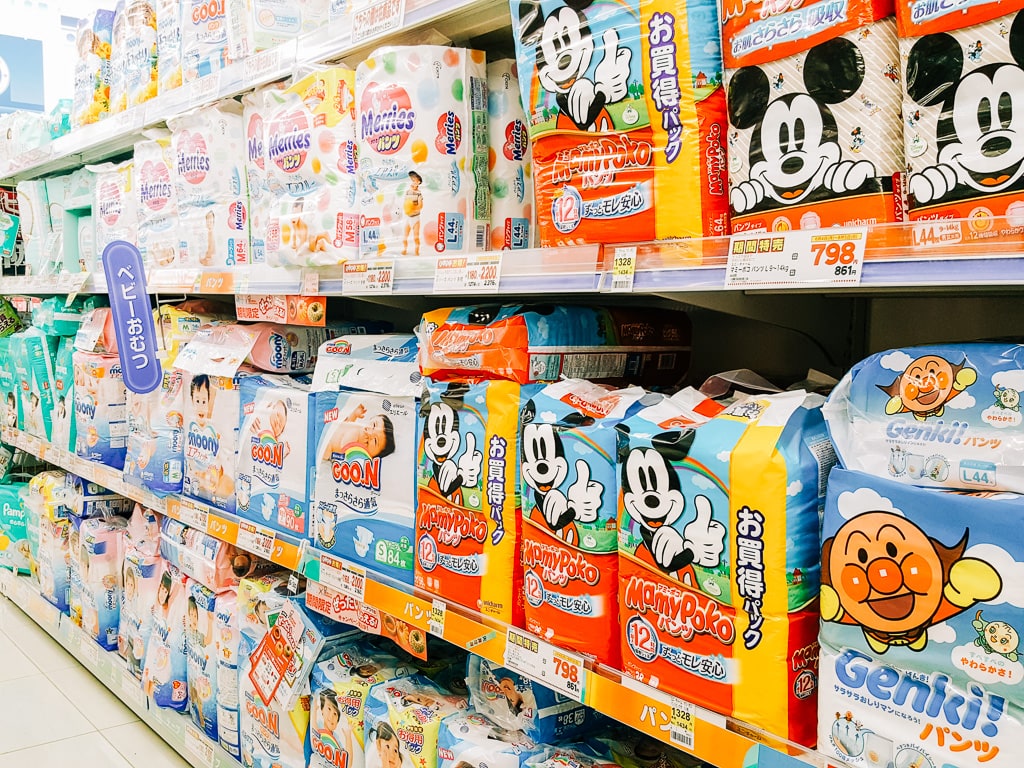
Thank you for this incredible review. You’ve put this mom’s travel concerns at ease. Very helpful!
Hi there.
I am Yusra, from Malaysia.
I will be travelling to Osaka & Kobe for 8 days.
I am bringing my 15 months old daughter. I planned to just buy diapers in Japan instead of bring it from Malaysia.
Here we use Genki. Can you share the price range for the diapers u mentioned in your post?
Thank you 😉
Hi Yusra, Price varies depending on the store, diaper size, and diaper count. Genki in Japan is pretty cheap 😉
Thank you so much for the article! I’m in Vietnam. In my country, most popular
baby diapers are from Japan. I have using Pampers and Goo.N . And I feel that Pampers is better for all
You’re welcome! I’m glad Pampers works for your baby! Thank you for dropping by!
Hi
i want selling in australia baby diaper . so can you give me more information and quotation for al brand baby diaper manufacturers direct
Thanks
lisa